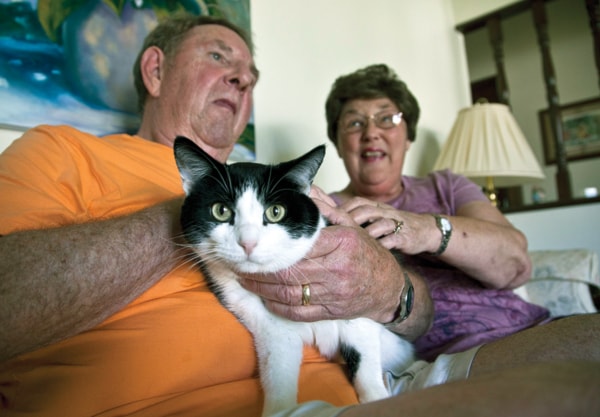Dogs have 42 teeth, humans have 32, cats have 30 and Mario has none.
The cat was eating poorly, hiding in the closet, and had red, sore gums when he was diagnosed with a mouth infection called stomatitis. Three surgeries and $10,000 later, all his teeth had been pulled.
“Once he started feeling better, he again became a happy, normal, healthy cat, very loving, affectionate and playful,” said Mary Roever of Green Bay, Wis., who with her husband adopted Mario from a shelter. “His cheek appears ever so slightly sunken in, but you really have to look to see it.”
The American Veterinary Medical Association estimates that by age two, 80 per cent of dogs and 70 per cent of cats have some form of dental disease.
Infections have been linked to diabetes, heart attacks, strokes, kidney disease and other life- threatening problems.
Dental disease was the most common problem found among the 2.2 million dogs and 450,000 cats treated at Banfield Pet Hospitals in 2010, according to the group’s “State of Pet Health 2011 Report.” With 770 hospitals in 43 states, Banfield is the world’s largest general vet practice.
It can be hard to tell if your dog or cat has a toothache, but there are warning signs, said Dr. Kevin S. Stepaniuk, president-elect of the American Veterinary Dental Society, and assistant clinical professor and veterinary dentist at the University of Minnesota’s College of Veterinary Medicine.
Bad breath, loose or discoloured teeth, cowering if touched on the jaw or snout, drooling, dropping food, bleeding from the gums, loss of appetite and loss of weight are some signs, Stepaniuk said.
Pets might also paw at their mouth and make exaggerated jaw movements when eating or drinking, he said.
“It hurts and it’s very smelly,” said veterinarian Edgardo Ortiz, Banfield’s medical director for New York and New Jersey.
“When the pets are healthy, owners will kiss them. With severe tooth trouble, people don’t want to kiss their pets so they don’t get as much love. That’s reality.”
Mario’s symptoms even included a squeaky meow, though it returned to normal after his surgery.
Still, there are a few things the toothless cat can’t do, Roever said: “He has no teeth to pick things up with. We pile his canned food up into a mountain so it’s easier for him to eat.” She also buys extra-small kibble.
Tooth decay can happen at any age, but is more likely in older pets and in smaller toy breeds.
“They eat more canned food and more will get stuck in their teeth,” Ortiz said. Larger dogs tend to eat more dry food, which scrapes the teeth, and helps remove tartar, he said.
“Ask yourself the question: ‘If you did not brush your teeth daily, what would happen?’ In a few days you would have significant plaque and, within a few more, increased tartar,” Stepaniuk said.
Owners are advised to take their pets to the vet twice a year for routine checkups and get their teeth cleaned once a year.
In a perfect world, Ortiz said pet owners would brush their dog’s or cat’s teeth twice a day, but twice a week will produce amazing results.
Add dental chews and a water additive that helps prevent tartar and pets should stay very kissable, Ortiz said.
Brushing an older pet’s teeth for the first time can prove challenging, the vets acknowledged, but it is easy to teach a puppy or kitten to learn to like it, Ortiz said.
“Start with your bare finger and rub it along their gums and teeth. Get them used to having something in their mouth. Then get a finger-sized toothbrush with small fibres that do not scrape the teeth,” he said. Toothpaste isn’t necessary to remove tartar, but once the pet is used to the brush, it can be added.
Cats usually won’t sit still for too long, so it helps if the toothpaste is tuna or chicken-flavoured, Ortiz said.
Stepaniuk warned not to give pets human toothpaste. “If human toothpaste is swallowed, which pets will do, it is toxic (due to the high levels of fluoride) as well as a gastrointestinal irritant,” he said.
Any invasive dental work on pets — extractions, root canals, and any thorough exam involving instruments and X-rays — requires anesthesia, Stepaniuk said. There are no such things as dog dentures, he said, and implants and bridges are almost non-existent, but some dogs — usually show dogs — do get braces.
Pets do cope with the loss of teeth, Ortiz said, and their health and behaviour typically improve once the pain is gone.
